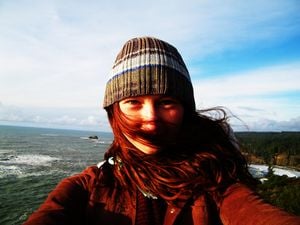
About Me
Name: CARRIE SCHADEN
"Heaven is ancient/ Earth is long lasting/ Why is this so?-/ Because they have no claim to life /By having no claims to life/ they cannot be claimed by death. The Sage puts his own views behind/ so ends up ahead/ He stays a witness to life so he endures/ What could he grab for that he does not allready have?/ What could he do for himself that the universe itself has not allready done?"Tao Te Ching
"We can have a positive impact on inevitable change by carefully observing and then intervening at the right time. Vision is not seeing things as they are but as they will and can be." Permaculture Principle
Education
BA in Geography, with a minor in Biomimicry Design from Humboldt State University
Life Experience
- I've volunteered at Potawot, United Indian Health Center's food garden, with T and Ed. Potowat is an integrated vision of environmental health, community health, and personal health as it weaves together ecological restoration, native plant cultivation for the tribes traditions, food gardening, fitness programs, Diabetes patient programs, and a high tech health facility soon to be accompanied by a child center.
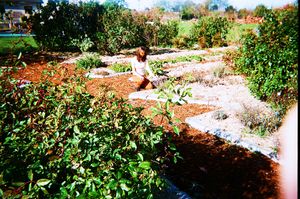
- I've also interned at Deep Seeded Community Farmwith Eddie Tanner. Eddie, author of "The Humboldt Kitchen Gardener" and "Food is Good Medicine", not only offers interns a chance to get hands on experience, but he also gives weekly lecture/discussions on methods, soil fertility considerations, and more.
- I'm a garden experimenter at home, in the middle of town I've got chickens and ducks, artichokes, fruit trees, and other perennials. I love permaculture practices and watching Bill Mollisonvideos.
- I've collected polypore Medicinal Mushroomsthat are a good overall health tonifier in Chinese medicine. Polypore's like ganoderma help with blood circulation, fight cancer, strengthens the immune system, detox, and regulates the liver and intestine. *I've been really inspired by Paul Stamens "Mycellium Running" and "Mushroom Cultivator". I hope to work with mycological bioremediationof heavy metal or oil contaminated areas in the future, especially in inner city areas being assessed for urban gardening.
- I've tried food preservation at home so that I can eat local out of season. I've made kimchi and pickles and frozen fruit. I've also made my own Kombucha and hard cider.
Must Read
- "Mycellium Running", by Paul Stamens [1]
- "Biomimicry" by Janine Benyus
- "Dreaming the Dark : Magic, Sex, and Politics" by Starhawk [2]
- "Omnivores Dilemma" and "Botany of Desire", by Michael Pollen
- "Stuffed and Starved", by Raj Patel [3]
- "Tao Te Ching"
- "A People's History of the United States", by Howard Zinn
- "Radical Healing" by Rudolph Ballentine
- now reading "The Shock Doctrine: The Rise of Disaster Capitalism" , Naomi Klein [4]
- now reading "The Hope: A Guide to Sacred Activism", by Andrew Harvey [5]
- now reading "Earth Democracy" by Vandana Shiva [6]
Interests in Appropriate Technology
- INTEREST #1 Permaculture,
Permaculture, or "permanent culture", is a set of food landscaping principles and practices that integrate different functions of nature and human use, that if separated as in our current culture lead to waste and problems, but when combined together are beneficial for the sustenance of each piece in the system. An example might be that aquaculture alone faces the problem of increased nitrogen build up, hydroponics alone faces the problem of severe nutrient and nitrogen depletion, when combined, aquaculture and hydroponics can turn problems into strengths for one another. Excess nitrogen from aquaculture feeds the hydroponic plants and the hydroponic plants clean the water by using the nitrogen and other sediments.
Like most appropriate technology with permaculture there is no generalized practice that can be used for all environments and cultures. Permaculture values native domesticated plant and animal varieties, seed saving practices by local farmers, and values the local farmer's wisdom and knowledge of the specific conditions of his land. In a sense this means that permaculture can NOT be a corporate model that sells things to local farmers, but rather permaculture arises from those farmers living in the local environment.
earthen water catchment [7] food forest [8] dryland permaculture [9]
- INTEREST #2 Earthships
Earthships are passive solar buildings made of recycled and natural materials. [10] Creator of Earthships [11]
- INTEREST #3 Natural building materials
Natural building materials including adobe sun dried mud bricks stuck together with mud mortar, cobb as much straw as possible mixed in a mud brick then stacked and sculpted into a wall, rammed earthearth rammed in wooden forms to make walls needing no external finishes, wattle and daub timber stakes inserted vertically have branches like willow woven around them then a muddy clay and straw mixture is applied, and Earthbags textile bags serve as a replacement for soils lacking enough clay to bind together, bags can be made of recycled clothes and packed full then plastered over so that as the textile decays the form will be left.
Experience in Appropriate Technology
- EXPERIENCE #1 Geodesic Bamboo Dome Green House, I helped build a geodesic dome based on the design by Buckminster Fuller [14]. Bamboo were latched together in hexagons made out of triangles, this design helped keep tension in the structure even without an earthen filler. A Plastic cover was fixed around it to keep in moisture and act as a green house in our garden. It was light weight, cheap to make, easy labor, and could be deconstructed and reconstructed at other sites with the same materials.
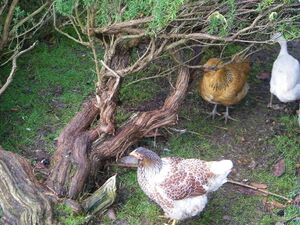
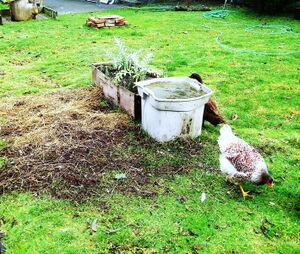
- EXPERIENCE #2 Chickens and Ducks integrated into a Perennial Urban Garden at home. We have two fruit trees as well as blueberry and service berry bush, artichokes, and herbs. The chickens keep our lawn trimmed, they fertilize our soon to be garden, help prepare the spring garden by scratching it up with their claws, and help control the slug population in the yard. The great thing about urban chickens and ducks is that we don't have to worry about raccoons or wolves the same as those out in the country. We give the chickens scraps collected from restaurants around town and in exchange receive the tastiest eggs.
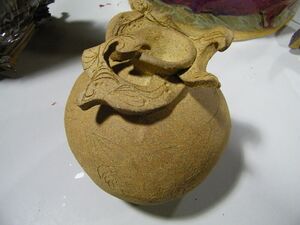
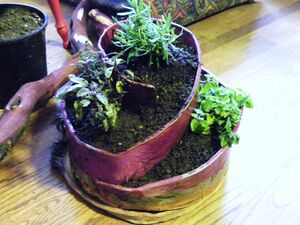
- EXPERIENCE #3 Recycled Art and Ceramics for the Garden. For recycled art I've made chimes out of chains and pipes, sculptures out of welded bike parts, blades, cans, plastic bottles and bags, and Christmas ornaments. For ceramics for the garden I've made a subterranean watering jug that is buried in the earth with only a hole exposed for filling with water. The clay has been fired without glaze thus it is porous enough for water to seep through and slowly water the adjacent plants for you over a long period. I've also made an indoor herb spiral (when I thought I was going to live in an apartment), the herb spiral utilizes vertical space, as well as optimizes on the different drainage and sunlight needs of different herbs.